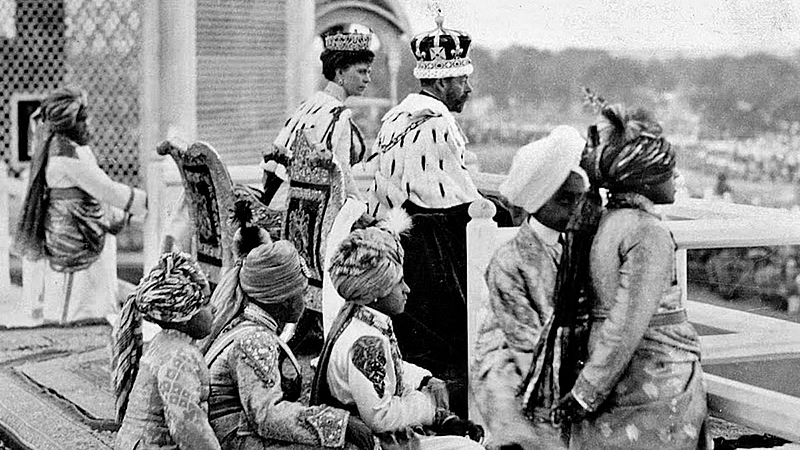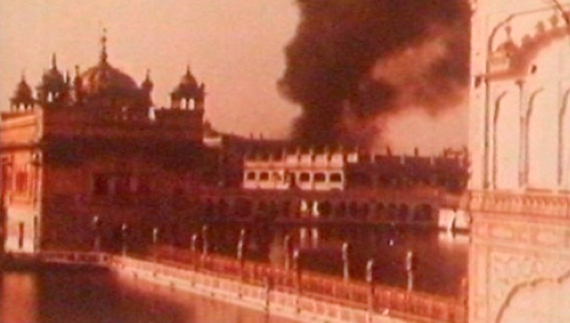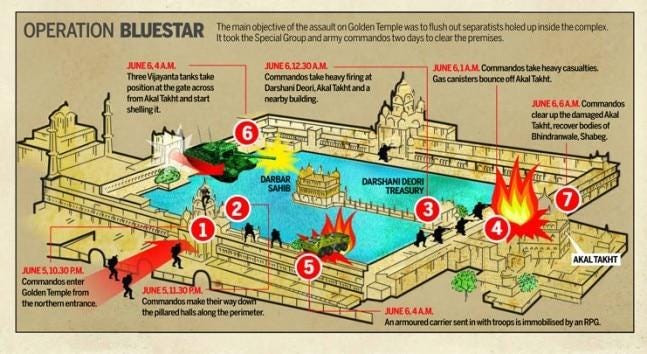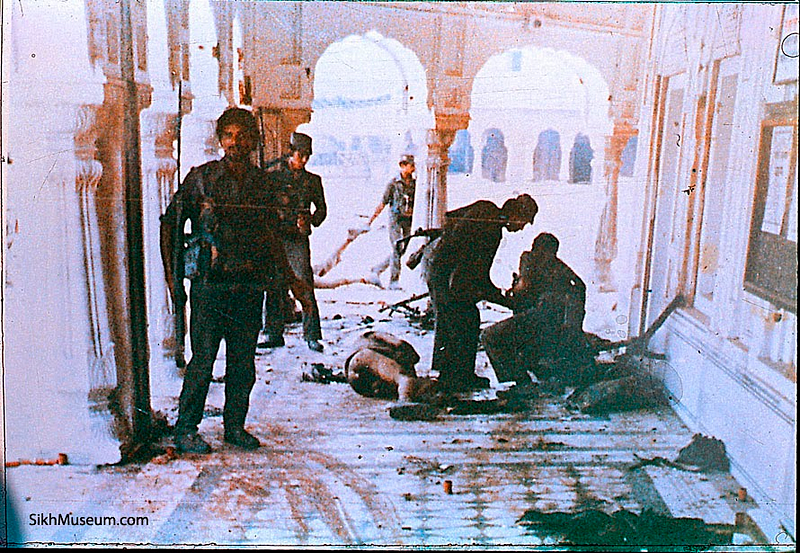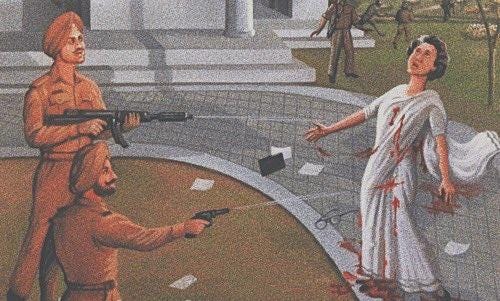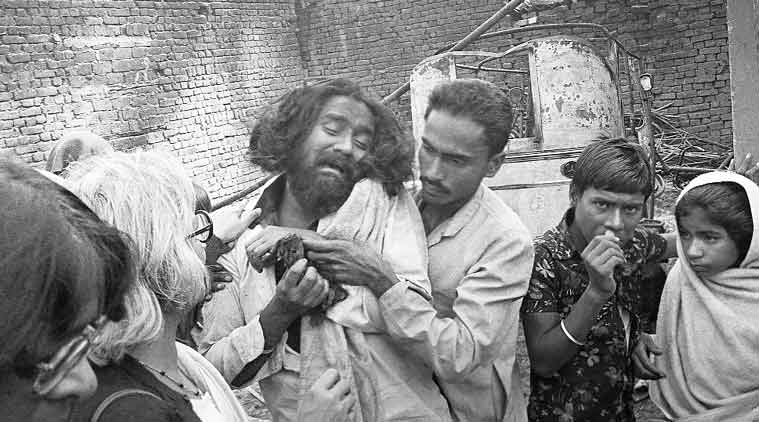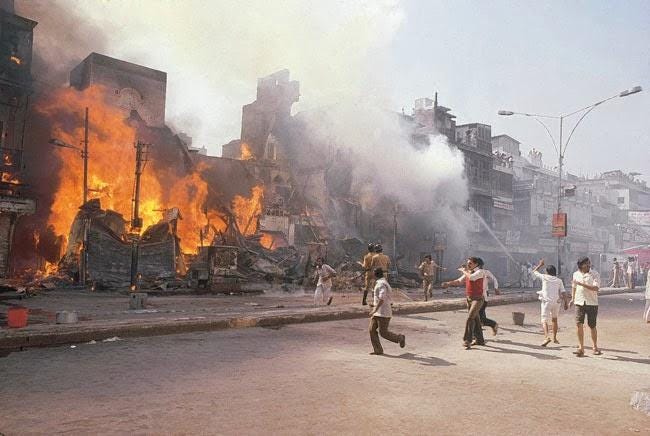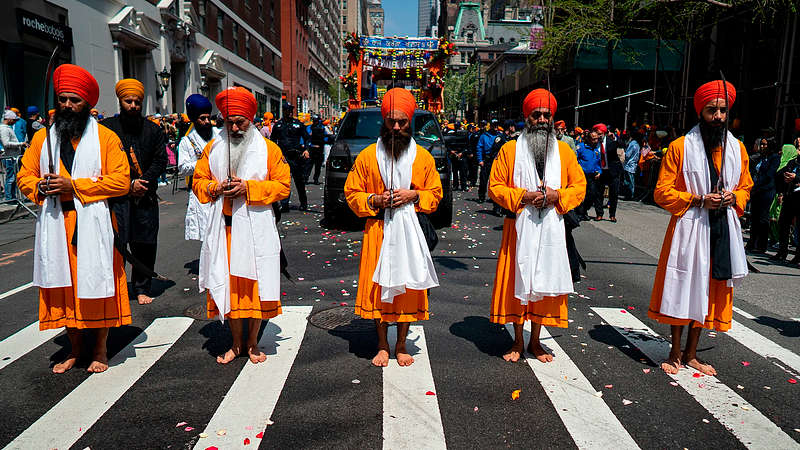1984 — The Truth That Was Never Told
Disclaimer: This article includes accounts from real eyewitnesses before, during and after the 1984 attack on the Golden Temple. For…
Disclaimer: This article includes accounts from real eyewitnesses before, during and after the 1984 attack on the Golden Temple. For personal reasons, the identities of these persons will remain anonymous. This article also includes graphic images with visuals of blood and death during the attacks in 1984.
A few years ago on my first trip to India, I had possibly one of the worst welcomes ever in my whole history of travelling. I was taken aback by the abrupt and impudent manner the officials at the immigration greeted me. I hadn’t known any better. But afterwards, when I got back to Malaysia and shared this story with many friends and family, there was one thing I realised: the Indians resented me. Or rather, us — the ones that managed to leave the country. Or so, that’s what I was told.
Growing up, I’ve heard the year 1984 being repeated over and over again. To my very little knowledge then, 1984 was the year when Indira Gandhi launched a full-fledged attack on our holiest Gurdwara — Sri Harmandir Sahib, famously known as the Golden Temple. I never understood the magnitude of the attack or how grave it affected Punjab and the Sikhs living then. All I knew was that we were never to forget 1984.
What follows will expose some serious allegations against the Indian government as well as the reality that was kept hidden from the public eye. The Indian government is a powerful institution that will take any and all measures to erase the truth from the history books and feed the world lies. Of course, when the Jews screamed for rescue, no one heard them first. It was only years later that the Nazis were shown to be the bad guys. There are many narratives of the truth but this is the unpopular version that was hardly ever spoken of — but happened.
Before 1984
Throughout the 300-year reign over India, what strengthened the British monarchy under Queen Victoria was the division of India into various sub-kingdoms that ruled different parts of the subcontinent. Britain took advantage of the ‘divide and rule’ approach, which kept a group of people with similar cultures or beliefs together in one location. However, under the influence of the infamous Mohandas Karamchand Gandhi, the lesser-known Bhagat Singh, and Subhas Chandra Bose, organised resistance against British rule began in India in the early twentieth century.
For the burgeoning independence movement, World War II was a defining moment. After exhausting all of their resources, the British gave up the fight and granted India freedom. Many people were unsure how this new nation would look after the declaration of independence in early 1947. Because Hindus and Muslims have never been the best of friends in the past, when the question of partition arose, the Hindus were keen to persuade the Sikhs to join India. Under the leadership of Jawaharlal Nehru and Gandhi, the Sikhs were promised the moon. And should they be unhappy with the terms at any point, they were free to leave the country.
It was all a ruse to entice the Sikhs to join them, so Nehru and Gandhi made lovely promises to the Sikhs but never kept them. When they saw the statements stating that Sikhism is a branch of Hinduism, Sikh leaders Master Tara Singh and Baldev Singh felt deceived and refused to sign the Indian Constitution. In addition, the constitution contains provisions to repeal the Anand Karaj (Sikh marriage) and replace it with the Hindu Marriage Act. When questioned, Nehru merely stated, “circumstances have now changed”. The constitution was put into effect even after the refusal. For the Sikhs, this was their first red flag.
Sikhs began to notice glaring changes in Punjab as the years passed. Punjab, which is derived from the words ‘five’ and ‘river’, was seeing fewer of them. Water had been redirected to other states, and crops were running dry. Small farmers, in particular, had been marginalised, alienated, uprooted, and their revenues pinched. There was no appropriate division of Punjab, and the land of Punjab gradually shrank as the government decided that a portion of Punjab belonged to another state every day. Even in their own country, Sikhs sensed the injustice as plain as day. As a result, the Akali Dals agreed that these treatments had to be stopped.
The Akali Dal (formally Shiromani Akali Dal) is a modern-day Sikhism regional political party that was founded on December 14, 1920. The aims of the Akali Dals are to protect Sikhs’ political rights and their religious platform, as well as to represent them in public bodies and legislative councils. The Akali Dals were formed to aid the Shiromani Gurdwara Parbandhak Committee (SGPC) — an elected organisation that oversees everything that happens in Gurdwaras (Sikh houses of worship) around the world. Within the Sikh community, they are regarded as the highest authority. On August 28th, 1973, the Akali Dals’ working committee unanimously adopted the Anandpur Sahib Resolution, which declared religious rules as well as political aims for Punjab and the Sikhs. The resolution, which was drafted in October 1973, outlined seven major objectives for achieving its political goal:
The transfer of the federally-administered city of Chandigarh to Punjab rather than leaving it shared with Haryana.
Readjustment of the boundaries of Punjab to incorporate certain Sikh-populated, Punjabi-speaking areas contiguous to the state.
The provision of a measure of provincial autonomy for all Indian states vis-à-vis the centre.
Land reform (so as to benefit the weaker in the population), nationalisation of key industries, and central government investment in establishing heavy industry in Punjab.
The promulgation of an all-India Gurdwara act to bring all Sikh shrines and temples under the control of the SGPC.
Protection for Sikh minorities outside Punjab.
Non-reduction of the recruitment quota for Sikhs in the armed forces.
Despite its controversial nature, the resolution was supported by a large number of Sikh intellectuals, servicemen, and politicians. The Akali Dals claimed that the resolution did not envision an autonomous Sikh state of Khalistan, but rather a system in which Sikhs may live their religious lives without interference. When the Akali Dals were faced with declining provincial power under Indira Gandhi’s centralising administration, they mobilised the Sikh peasantry in a major campaign for Punjab’s autonomy in 1980. The initiative was based on a set of demands that included economic, cultural, constitutional, and religious concerns. The Akali Dal staged seven nonviolent protests between August 1980 and September 1981. In February 1981, the party decided to work for the implementation of the Anandpur Sahib Resolution, which resulted in the 1981- 1984 Dharam Yudh Morcha (Righteous Struggle), which offered four fundamental demands:
Recasting the Indian constitution to increase states’ autonomy.
The return of Chandigarh to Punjab.
State control over river waters.
An all-India Gurdwaras Act.
After countless negotiations with the Indian government, Indira Gandhi, at last, rejected the Anandpur Sahib Resolution in 1984 and launched Operation Bluestar; which is when the horror began.
The Launch That Brought Chaos
It wasn’t an impulsive decision made in the spur of the moment to launch an attack on one of the holiest places on the face of the earth. Months of precise planning went into attempting to neutralise a single individual who required such a large army of heavy artillery and tanks. One can only imagine and ask themselves: how powerful a man was he?
Sant Jarnail Singh Bhindranwale was no terrorist but was relentlessly vilified as one. Terrorists are defined as people who use unlawful violence and intimidation, especially against civilians, in the pursuit of political aims — none of which were the actions of Sant Ji. He was the leader of Damdami Taksal when Indira Gandhi accused him of being a terrorist or, more accurately, a ‘separatist’ who desired Khalistan (Land of Khalsa), a movement to create a homeland for Sikhs through the establishment of a sovereign state. Sant Ji’s preaching in Punjab in the late 70s and early 80s touched many hearts, and he was one of the most powerful figures of his time. However, he never once made a demand for Khalistan during any of his speeches. Dr Subramaniam Swamy maintains his stance on Sant Ji, claiming that during his preaching, Sant Ji was plainly speaking out against narcotics and other social issues in Punjab. There is no doubt that Sant Jarnail Singh Ji was a member of the Dharam Yudh Morcha launched by the Akali Dals and led by Harchand Singh Longowal, although he did it so out of political obligation in hopes for a better Punjab with the approval of the Anandpur Sahib Resolution. With all that was happening all too much and all too fast, Indira felt threatened.
Indira Gandhi is said to have discussed ‘Operation Sundown’ with a few government officials, but it was eventually called off because she was unhappy with the number of casualties her officials told her about. Then, months later, she ordered her soldiers to clear the shrine of ‘militants’. There were much more casualties than the 20% of commando force and two helicopters casualties that Operation Sundown had projected. Now the question begs, was she truly concerned about the number of casualties, or was she dissatisfied with the number of people who had to die?
Sikhs in Punjab had an especially difficult time in the years leading up to Bluestar. The events that transpired during the attack are too extensive to be detailed in this article. These were the darkest days in the history of the Sikhs. Thousands of innocent civilians were killed in the eight-day attack that took place between June 1st and June 8th, 1984, as they gathered to commemorate the martyrdom of the Sikhs’ fifth Guru, Guru Arjan Dev Ji. The Army’s tank blast damaged historic buildings, as well as countless records and scriptures from the library that were vital to the Sikh faith. Sant Ji and his 250 valiant Sikh troops held off the army for as long as they could, but they were no match for the army’s massive arsenal of tanks, helicopters, bombers, and other heavy artillery that destroyed the Akal Takht.
The attack, which was carried out under the guise of “flushing out terrorists”, instead resulted in the greatest amount of damage to the Temple Complex and innocent Sikh onlookers. Thousands of Sikhs took to the streets to protest the heinous attack on their holiest shrine. Thousands of Sikh Army personnel were martyred in the hallowed precincts of the Darbar Sahib (the Golden Temple), while hundreds of others fled their posts and ran to Darbar Sahib’s shelter. During the battle with the Indian Army, Sant Ji died a martyr. More information about what happened during the incident may be found here. In 1985, the SGPC launched a $1 billion damages suit against the Indian Army in relation to Operation Bluestar.
Operation Woodrose was a follow-up to Operation Bluestar, which was carried out all over Punjab from June to September 1984, immediately after the attack on Harmandir Sahib. The Indian Army, once again, used severe force against innocent civilians, employing tanks, artillery, helicopters, and armoured vehicles. It was a plan to eradicate Sikh militancy by going to every hamlet and town to capture suspected militants, which ended in the torture and murder of thousands of young innocent Sikhs. If the initial goal was really just to take out Sant Ji, that one person who seemed to have the power to cause tremors and fear amongst the Indian government, why not stop there? What was the logic behind Woodrose? It was clear as day that Indira Gandhi meant to exterminate the whole Sikh population.
The Indian army would go to villages and take the Sikhs, humiliate them in public, and then kill or detain the majority of males. Women were also degraded in many ways, including raping and forcing them to walk around naked on the streets. The army particularly targeted young Sikhs and it resulted in the death of thousands of Sikhs. Indira’s apparent hostility toward Sikhs was not missed. This was the final stretch. The Sikhs had suffered long enough.
An Eye for An Eye: The Assassination of Indira
Committing such heinous atrocities on a particular group of a certain belief, singling them out while attacking them in their homes — Sikhs around the world breathed a sigh of relief on October 31 1984. Just a few months after the attack on Harmandir Sahib, Indira Gandhi was assassinated at her home in New Delhi by two of her Sikh bodyguards, Satwant Singh and Beant Singh, in a similar manner to how she murdered the innocent Sikhs in their homes. For the sake and love for their religion, Beant Singh and Satwant Singh had embraced death even before pulling the trigger on Gandhi as she walked to her office from an adjoining residence. Although they immediately surrendered, both were shot in a subsequent scuffle, and Beant died.
After the attack in 1984, Beant Singh, who was her long-time bodyguard, was to be transferred because he was a Sikh and they feared an assassination. However, Gandhi personally rescinded the transfer order because she trusted him after his many years of service. Obviously, this was a fatal mistake on Indira’s part because she had underestimated Beant’s loyalty toward his religion. Satwant Singh, who survived the gunshot to stand trial, was convicted in 1986 and executed in 1989. Gandhi’s assassination triggered genocidal killings around the country, but one, in particular, was India’s capital city, New Delhi. More than 1,000 innocent Sikhs were killed in indiscriminate attacks over the course of two days.
Post Assassination — Anti Sikh Pogrom
The 1984 Sikh pogroms in India were a premeditated state massacre carried out across the country by politicians and police after Indira Gandhi was assassinated by Sikh bodyguards. Frenzied gangs of young Hindu thugs, thirsty for vengeance, burned Sikh-owned stores to the ground, dragged Sikhs out of their homes, vehicles, and trains, then clubbed them to death or set them on fire before raging off in search of more victims just hours after the assassination. Witnesses watched in horror as crowds raped Sikh women, murdered Sikh men, and set fire to Sikh homes, businesses, and Gurdwaras on the streets of New Delhi. According to eyewitness accounts, police enforcement and government officials took part in the atrocities by participating in the violence, urging civilians to take revenge, and arming the mobs.
Death squads pursued and slaughtered Sikhs, including children, from the day of Gandhi’s death on October 31st until November 4th; raped Sikh women; and burned gurdwaras, homes, and businesses. The pogroms continued unabated, and within three days, approximately 3,000 Sikhs had been murdered according to official reports. Unofficial death tolls are even higher, and human rights advocates have identified individuals who were involved in the planning and execution of the murders.
The perpetrators of the massacres have escaped justice. In fact, the major investigators were given government jobs and were not prosecuted. India’s failure to bring the perpetrators of these killings to justice has resulted in widespread communal violence in other parts of the country, usually with official complicity. The Indian government is far from the first to slaughter its own people. Nonetheless, many other countries that participated in ethnic cleansing, such as Chile, Argentina, Rwanda, and South Africa, have realised the significance of confronting past atrocities. Despite overwhelming evidence to the contrary, the Indian government steadfastly refuses to admit fault and take responsibility for its role in this mass bloodshed. Impunity for these massacres reinforces India’s reputation as a country that fails to follow the rule of law and protection of human rights.
No Justice, No Acknowledgement Yet
Sikhs have yet to receive justice after 38 years, and the United Nations has yet to recognise this as a violation of the Sikhs’ human rights. Even though there is substantial evidence to the contrary, India continues to deny committing such atrocities against Sikhs. Survivors who have been raped, tortured, or who have lost loved ones have not received the apology they deserve. The anguish experienced by mothers, sisters, and wives is indescribable. Sikhs were treated unjustly and unfairly by Indians because they claimed what was rightfully theirs.
Sikhs are threatened in the very place they should feel safe. Punjab is the birthplace of Sikhism, and the Sikhs have a rightful claim to the land of five rivers as heirs of prior generations. The Indian government, however, has been ruthless and unkind to the Sikhs who live there for political reasons. Even when the issue of Khalistan arose (which is understandable given that they were promised from the start that they may leave if they were unhappy), the Indian government took it upon itself to eradicate Sikhs. This explained why the immigration officer resented us, the NRIs. Being a minor in Malaysia is still very much better as compared to being a minor in India.
Sikhs may be few in numbers, but history has proven that every time you try and take out the Sikhs, like in the events of Jallianwala Bagh, we only come back tenfold stronger. We know that this isn’t the end of it, there is still more to come, and for when the time comes, we shall be prepared then.
[Written by: Balvinder Kaur Dhaliwal. Edited by: Siow Chien Wen.]
Note: This article has been written based on the opinion of the author and does not in any way reflect the view of the organisation.


